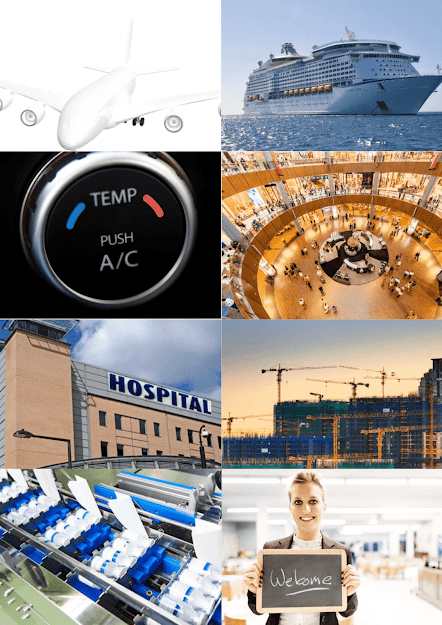 |
| HVAC CLASSIFICATION |
INTRODUCTION
Hello, everyone, I'm Design and Work MEP, Welcome to the field of
HVAC system, in this blog I will tell you about the Heat Ventilation Air Conditioning System which is a very necessary job profile for a Mechanical Engineer.
HVAC System
A heating, ventilation and air-conditioning system which maintains the temperature, relative humidity and air quality in a room or building within defined limits.
H is for Heating V for ventilation A for Air and C for conditioning all these terms comes from the American Society of Heating Refrigeration and Air Conditioning Engineers.
Few people think that
HVAC is all about Luxury, Waste of Money and Valuable Energy but of course, it is
the right of every individual to live in Comfort and HVAC is committed for it.
Also, HVAC serves the industrial segment to a great extent.
Various applications of Air conditioning in the industries are,
 |
| Applications of Air Conditioning |
Aeroplanes, ships, automobiles, Shopping malls, Auditoriums & Theatres, Hospitals, Hotels and Restaurants, Offices, Commercial Complex, Pharmaceuticals, also for formal critical industries Telecom Industries, Transportations and other special applications.
Jobs in HVAC
In various ways like Marketing, Designing,
Estimation, Procurement, Installation, Fabrication, Testing & Commissioning
and Maintenance.
History of HVAC
|
IN 1851 |
DR John Gorrie granted U.S Patent No: 8080 for refrigeration machine. |
|
IN 1880 |
Refrigeration became available for industrial purposes. Initially two main uses. 1) Freezing meat for transport. 2) Making ice. |
|
In 1900 |
Air-conditioning technology has developed through the joint accomplishments of science and engineering. |
|
In 1902 |
The first modern air conditioner was invented by Willis Haviland Carrier. |
|
In 1902 |
The first comfort cooling system for the New York stock exchange. |
|
In 1954 |
Voltas launched India’s first Air conditioner. |
Need Of HVAC
- Improvement of air quality.
- To make building a comfortable and safe environment and to do so at least cost for energy and maintenance.
- To keep it more comfortable inside the house then it outside.
Function of HVAC
- To provide a healthy and comfortable interior condition for inhabitant.
- Moisture Regulation (humidity).
- Control of air temperature.
- Proper air movement for holding the air contamination within acceptable limits.
- Energy conservation.
- Filtration of airborne particles.
Advantages of HVAC
- Conserves Energy.
- Regulates Moisture.
- Air Quality Improvement.
Disadvantages of HVAC
- Initial installation cost is high.
- Primary disadvantages of ductless air conditioners are their cost.
REFRIGERATION
- The term refrigeration may be defined as the process of removing heat from a substance under controlled conditions.
- It also includes the process of reducing heat and maintaining the temperature of a body below the general temperature of its surrounding.
Main components are;
- Compressor
- Condensor
- Expansion Device
- Evaporator
Function of Refrigeration
- The application of refrigeration for domestic purposes are mainly in the form of local refrigerators & home freezers.
- To provide low temperature for storage and distribution of foods and drinks.







0 Comments
In order to improve the blog, suggestions and criticism, if any, are welcome.